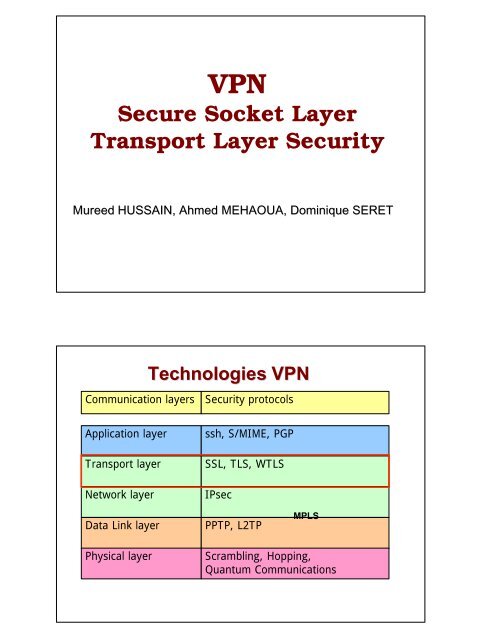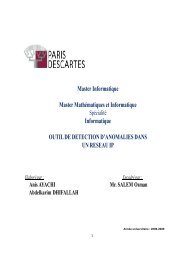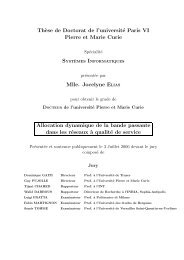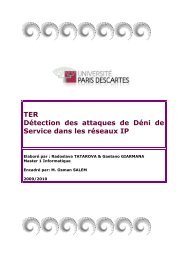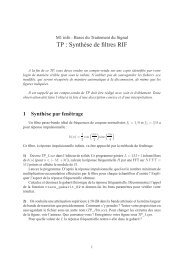Secure Socket Layer Transport Layer Security
Secure Socket Layer Transport Layer Security
Secure Socket Layer Transport Layer Security
You also want an ePaper? Increase the reach of your titles
YUMPU automatically turns print PDFs into web optimized ePapers that Google loves.
VPN<br />
<strong>Secure</strong> <strong>Socket</strong> <strong>Layer</strong><br />
<strong>Transport</strong> <strong>Layer</strong> <strong>Security</strong><br />
Mureed HUSSAIN, Ahmed MEHAOUA, Dominique SERET<br />
Technologies VPN<br />
Communication layers <strong>Security</strong> protocols<br />
Application layer ssh, S/MIME, PGP<br />
<strong>Transport</strong> layer SSL, TLS, WTLS<br />
Network layer IPsec<br />
Data Link layer PPTP, L2TP<br />
MPLS<br />
Physical layer Scrambling, Hopping,<br />
Quantum Communications
• Introduction<br />
Agenda<br />
– Motivation, evolution, standardization<br />
– Applications<br />
• SSL Protocol<br />
– SSL phases and services<br />
– Sessions and connections<br />
– SSL protocols and layers<br />
• SSL Handshake protocol<br />
• SSL Record protocol / layer<br />
• SSL solutions and products<br />
• Conclusion<br />
Sécurisation curisation des échanges changes<br />
• Pour sécuriser les échanges ayant lieu sur le réseau<br />
Internet, il existe plusieurs approches :<br />
- niveau applicatif (PGP)<br />
- niveau réseau (protocole IPsec) IPsec)<br />
- niveau physique (boîtiers chiffrant).<br />
• TLS/SSL vise à sécuriser les échanges au niveau de la<br />
couche <strong>Transport</strong>. <strong>Transport</strong><br />
• Application typique : sécurisation du Web
<strong>Transport</strong> <strong>Layer</strong> <strong>Security</strong><br />
• Advantages<br />
– Does not require enhancement to each application<br />
– NAT friendly<br />
– Firewall Friendly<br />
• Disadvantages<br />
– Embedded in the application stack (some mis-implementation)<br />
– Protocol specific --> need to duplicated for each transport<br />
protocol<br />
– Need to maintain context for connection (not currently<br />
implemented for UDP)<br />
– Doesn’t protect IP adresses & headers<br />
<strong>Security</strong>-Sensitive Web<br />
Applications<br />
• Online banking<br />
• Online purchases, auctions, payments<br />
• Restricted website access<br />
• Software download<br />
• Web-based Email<br />
• Requirements<br />
– Authentication: Of server, of client, or (usually) of both<br />
– Integrity: Of requests, of responses, etc.<br />
– Confidentiality: Of data transfers<br />
– Availability: No Denial of Service<br />
• Some minor applications : SSL VPN (end-to-end)<br />
• Main tool: SSL / TLS protocol
IPsec et l’architecture l architecture TCP/IP<br />
TLS SSL<br />
Physique Cuivre, Fibre Optique, Ondes Radio, ...<br />
<strong>Transport</strong> <strong>Layer</strong> <strong>Security</strong><br />
Protocols<br />
• Connectionless and connection-oriented transport layer<br />
service:<br />
– <strong>Security</strong> Protocol 4 (SP4) – NSA, NIST<br />
– <strong>Transport</strong> <strong>Layer</strong> <strong>Security</strong> (TLSP) – ISO<br />
• Connection-oriented transport layer service:<br />
– Encrypted Session Manager (ESM) – AT&T Bell Labs.<br />
– <strong>Secure</strong> <strong>Socket</strong> <strong>Layer</strong> (SSL) – Netscape Communications<br />
– <strong>Transport</strong> <strong>Layer</strong> <strong>Security</strong> (TLS) – IETF TLS WG<br />
Most popular transport layer security protocols
No client auth;<br />
weak encryption;<br />
Man-in-the-midle<br />
attack<br />
Not released<br />
SSLv1<br />
(1994)<br />
SSL/TLS Evolution<br />
SSLv2<br />
(1994)<br />
Microsoft’s<br />
improved SSLv2:<br />
security (e.g. strong<br />
exportable auth.),<br />
performance (flows)<br />
PCT<br />
(1995)<br />
SSLv3<br />
(1995)<br />
Substantial redesign;<br />
add client authentication,<br />
support for DSS, DH,<br />
prevent truncation attack<br />
DSS : Digital Signature Standard (Public ( Public-key key)<br />
DH : Diffie-Hellman<br />
Diffie Hellman<br />
STLP<br />
(1996)<br />
SSL-TLS<br />
Microsoft’s<br />
improved SSLv3:<br />
support for UDP,<br />
and shared-secret<br />
authentication<br />
WTLS<br />
(1990-)<br />
TLS 1.0<br />
(1997-1999)<br />
RFC 2246<br />
SSLv3 but incompatible:<br />
improved key expansion<br />
and MAC, support 3DES<br />
and DH+DSS for key<br />
exchange<br />
• SSL : <strong>Secure</strong> <strong>Socket</strong> <strong>Layer</strong> (version 3) from Netscape<br />
• TLS is defined in Internet Engineering Task Force (IETF ( IETF) )<br />
RFC Document 2246, 2246,<br />
see e.g. at www.ietf.org<br />
• Intermediate security layer between the transport layer<br />
and the application layer<br />
• Based on connection-oriented<br />
connection oriented and reliable service (e.g.,<br />
TCP)<br />
• Able to provide security services for any TCP-based TCP based<br />
application protocol, e.g., HTTP,FTP, TELNET, POP3, etc.<br />
• Application independent<br />
WAP<br />
TLS 1.1<br />
(2001-?)
SSL Services<br />
• Server authentication (mandatory)<br />
• Client authentication (optional – if required by the server,<br />
and if the client has a certificate)<br />
• <strong>Secure</strong> connection:<br />
– Authentication and Integrity: Of messages<br />
– Confidentiality: Message encryption is optional<br />
– Reliability: Prevent message re-ordering, re ordering, truncating, etc.<br />
• Efficiency:<br />
– Allows resuming old SSL sessions in new connections<br />
• <strong>Secure</strong> negotiation of the cipher-suite cipher suite<br />
SSL/TLS principles<br />
• Client server<br />
• Provide 4 security services :<br />
– Authentication of server<br />
– Confidentiality of exchanged data<br />
– Integrity of exchanged data<br />
– Optional : authentication of client (if client has a certificate) certificate<br />
• Combining various security mechanisms :<br />
– Asymmetric Ciphering : authentication (RSA)<br />
– Certificate : to validate public key of the server<br />
– Symmetric Ciphering : Confidentiality of data transmission<br />
– Hach function : integrity of data<br />
© Ahmed Mehaoua - 12
Principe de fonctionnement de SSL:<br />
Exemple du paiement en ligne<br />
Sécurisation des<br />
transactions par SSL<br />
Le serveur marchand crée<br />
une clef de session en<br />
cryptant un message<br />
aléatoire à l'aide de la clef<br />
publique, puis l'envoie au<br />
client<br />
Le client, connecté au site<br />
marchand sécurisé par SSL, clique<br />
sur un lien hypertexte déclenchant<br />
une requête de formulaire sécurisé<br />
et la création d'une clé privée que<br />
le client va conserver, et d'une clé<br />
publique qui sera expédiée au<br />
serveur marchand<br />
A réception, le client crypte la clef de session<br />
à l'aide de la clef privée, puis l'envoie au<br />
serveur marchand, qui va la décrypter à<br />
l'aide de la clé publique afin de vérifier<br />
l'authenticité du message, donc de<br />
l'acheteur<br />
Le reste des transactions peut alors se faire à l'aide de la clef clef<br />
de session,<br />
connue des deux côtés et inconnue des autres entités du réseau<br />
SSL/TLS in a Nutshell<br />
• SSL & TLS provide a `secure `secure<br />
TCP tunnel from client to server`: server`:<br />
– Message Confidentiality<br />
– Message and connection integrity<br />
– Authentication of server, optionally also of client<br />
• Implemented in almost all web clients, servers<br />
• Many implementations, libraries, e.g. Open-SSL Open SSL<br />
• SSL: <strong>Secure</strong> <strong>Socket</strong> <strong>Layer</strong><br />
– Version 3 designed by Netscape Corp.<br />
– Original goal and main use: secure credit card number<br />
– SSL (& TLS) operate on top of `standard` <strong>Socket</strong>s API<br />
• TLS: <strong>Transport</strong> <strong>Layer</strong> <strong>Security</strong><br />
– Version 1.0 – RFC 2246<br />
– IETF standard version of SSL<br />
– We usually say just SSL but refer to both
Chiffrement asymétrique<br />
PB : Tout repose sur la confiance dans la provenance<br />
de la clef publique ?<br />
• Si celui qui forge une signature a forgé forg la clef<br />
publique de sa victime ?<br />
• Autrement dit si celui qui souhaite écouter couter les<br />
messages de votre correspondant vous a remis une<br />
fausse clef publique pour cette personne ?<br />
Certificat X509 :<br />
La solution au problème<br />
• Solution : une autorité de certification (CA pour<br />
Certification Authority) Authority)<br />
est chargée de signer les<br />
clefs publiques : elle chiffre (avec sa clef privée) une<br />
empreinte de :<br />
– L’identité de son titulaire, personne, serveur ou application<br />
(Distinguished<br />
Distinguished Name of Subject) Subject<br />
– La clef publique<br />
– Les informations relatives à l’usage de cette clef, (période<br />
de validité, type des opérations possibles, etc). etc).<br />
• L’ensemble est appelé certificat X509. X509.<br />
Les certificats<br />
X509 font l’objet d’une norme : ITU-T ITU T X509<br />
international standard V3 1996, RFC2459
Certificat X509<br />
- Autorité de certification -<br />
• La CA (Certification<br />
( Certification Authority) Authority)<br />
est une organisation qui délivre<br />
des certificats à une population.<br />
• Il existe des autorités privées (intranet d’une entreprise),<br />
organisationnelles (CRU, CNRS), corporative (notaires),<br />
commerciales (Thawte ( Thawte, , Verisign, Verisign,<br />
…), très commerciales<br />
(microsoft microsoft), ), institutionnelles, etc<br />
• On s’assure de la provenance d’une clef publique en vérifiant la la<br />
signature qui y a été apposée à l’aide de la clef publique de<br />
l’autorité de certification (CA). (CA)<br />
• Plus besoin de faire directement confiance à toutes les clefs<br />
publiques en circulation mais seulement à celles des autorités<br />
de certification.<br />
Public Key Certificates<br />
• Similar to passport or driver’s license<br />
• Binds a public key to a name (Alice) and/or other attributes of<br />
keyholder, keyholder,<br />
e.g. DNS name for web site<br />
• Signed by a trusted party (Issuer / Certification Authority) (SNCF)<br />
• Allows relying party (Bob, client) to validate name, attributes of key<br />
owner (Alice, web site)<br />
Issued<br />
by:<br />
SNCF<br />
Name: Alice<br />
ID 3783597<br />
Signature:<br />
Issuer<br />
(DNS) Name<br />
Info<br />
Attributes<br />
Public Key<br />
Issuer’s Issuer s signature:<br />
Sign Lib(Info Lib(Info)
Exemple de Certificat X509<br />
Certificat X509<br />
- Les usages -<br />
• Messagerie S/MIME : signature (certificat de<br />
l’émetteur) et/ou chiffrement (certificat du<br />
destinataire)<br />
• SSL ou TLS : en particulier HTTPS pour chiffrer les<br />
sessions du client et authentifier le serveur. Plus<br />
rarement authentifier le client.<br />
• SSL POPS, IMAPS, LDAPS, SMTP/TLS, …<br />
• VPN avec IPsec
Web <strong>Security</strong> with SSL/TLS (simplified)<br />
6. Display:<br />
-- Page<br />
-- URL<br />
-- Padlock<br />
2. Domain<br />
(bank.com)<br />
1. URL/Link<br />
https://bank.com<br />
4a. Hello<br />
4c. E pk(key)<br />
3. IP (67.22.5.2)<br />
Domain Name<br />
System (DNS)<br />
cert=SignCA(pk, domain)<br />
4. SSL/TLS: Establish key using pk…<br />
5. SSL/TLS: Protect using key…<br />
5a. HTTP Get (www.bank.com)<br />
5c. HTTP Post (userid/pw)<br />
4b. pk, cert<br />
5b. Web (login) page<br />
Fonction de hachage<br />
cryptographique<br />
Certificate<br />
Authority (CA)<br />
e.g. VeriSign<br />
www.bank.com<br />
(Web<br />
Server, at<br />
67.22.5.2,<br />
Port 443)<br />
Une fonction de hachage compresse les données fournies en une chaîne de<br />
taille constante. Pour une fonction de hachage cryptographique, il est impossible<br />
de trouver :<br />
- Deux entrées qui ont le même résultat (résistant à la collision),<br />
- Une entrée différente pour une entrée donnée avec le même résultat.<br />
Ces fonctions sont utilisés pour assurer :<br />
l’authentification des systèmes et/ou des messages échangés,<br />
L’intégrité des messages échangés<br />
Les fonctions les plus connues sont : MD5, SHA1, Kerberos, …<br />
Les applications courantes sont :<br />
Dans S/Key (Linux) pour fournir des mots de passe utilisable une seule fois.<br />
Dans IPSec et ISAKMPD pour authentifier l'origine des données et assurer<br />
l'intégrité du paquet.<br />
Dans Linux pour les mots de passe MD5 (non activé par défaut), voir<br />
passwd.conf.<br />
Dans SSL pour la signature numérique des messages.
Transformation cryptographique<br />
Les transformations cryptographiques sont utilisées pour chiffrer et déchiffrer les<br />
données. Elles sont normalement utilisées avec une clé de chiffrement qui peut<br />
être privé (transformation symétrique) ou une paire de clé publique+privée<br />
(transformation asymétrique).<br />
Ces transformations sont utilisés pour assurer :<br />
La confidentialité des messages échangés<br />
Les transformations les plus connues sont : DES, 3DES, AES, Blowfish, RSA …<br />
Les applications courantes sont :<br />
Dans la libc (Linux) pour créer des mots de passe Blowfish.<br />
Dans IPsec pour fournir la confidentialité au niveau de la couche réseau.<br />
Dans ISKMPD pour protéger les échanges lorsque des clés IPsec sont<br />
négociées.<br />
Dans AFS pour protéger les messages transitant sur le réseau, fournissant<br />
la confidentialité lors de l'accès au système de fichiers distant.<br />
Dans SSL pour permettre aux applications de communiquer à l'aide du<br />
protocole cryptographique SSL (qui est un standard de fait).<br />
Certification Authorities<br />
• Certification authority (CA): binds public key (e.g. B.v, B.v,<br />
B.e) B.e)<br />
to<br />
identifier (e.g. B.name=`Bob`<br />
B.name=`Bob`).<br />
).<br />
• Bob (person, server) registers B.v, B.v,<br />
B.e with CA.<br />
– Bob convinces the CA his name is Bob, sends B.v, B.v,<br />
B.e. B.e<br />
– CA creates certificate binding “Bob” to B.v, B.v,<br />
B.e. B.e<br />
– Certificate is digitally signed by CA – CA says “B.e “ B.e is Bob’s public<br />
encryption key”<br />
Bob’s<br />
identifying<br />
information<br />
Bob’s<br />
public<br />
key B.e<br />
CA<br />
digital<br />
signature<br />
CA<br />
private<br />
key CA.s<br />
Bob<br />
B.e<br />
certificate for<br />
B.e (as Bob’s key),<br />
signed by CA
Using Public Key Certificates<br />
• When Alice wants Bob’s public key (to encrypt message to Bob<br />
or validate Bob’s signature):<br />
– gets Bob’s certificate (Bob or elsewhere).<br />
– apply CA.v (public validation key) to Bob’s certificate, get<br />
Bob’s identity, public keys, …<br />
“Bob”, B.e, B.s,<br />
B.attr, validity,…<br />
SSL Architecture<br />
SSL is built in two layers:<br />
digital<br />
Signature<br />
validate<br />
CA<br />
public<br />
key CA.v<br />
Bob<br />
B.e<br />
Bob’s<br />
name,<br />
public<br />
key and<br />
attributes<br />
SSL Handshake <strong>Layer</strong> – used for managing SSL exchanges<br />
(cipher suite negotiation, session key generation, etc.)<br />
SSL Record <strong>Layer</strong> – used to secure communication between<br />
client and server with the established session keys<br />
Application<br />
Handshake layer<br />
Record layer
SSL Main Protocols<br />
SSL Record Protocol<br />
<strong>Layer</strong>ed on top of a connection-oriented connection oriented and<br />
reliable transport layer service<br />
Provides message origin authentication, data<br />
confidentiality, and data integrity<br />
Handshake Protocol<br />
Used to mutually authenticate client and<br />
server and exchange session key<br />
page 27
SSL Sub-Protocols<br />
Sub Protocols<br />
<strong>Layer</strong>ed on top of the SSL Record Protocol<br />
Provides support for SSL session and connection<br />
establishment<br />
Alert Protocol<br />
Used to transmit alerts via SSL Record Protocol<br />
Alert message: (alert level, alert description)<br />
ChangeCipherSpec Protocol<br />
Used to change cipher specifications<br />
Can be changed at the end of the handshake or later<br />
Application Protocol<br />
Used to directly pass application data to the SSL Record<br />
Protocol<br />
SSL Operation Phases<br />
Client uses SSL API to open connection<br />
TCP Connection Phase<br />
Handshake Phase (SSL Handshake Protocol)<br />
Negotiate (agree on) algorithms, methods<br />
Authenticate server and optionally client<br />
Establish keys<br />
Establish connection (keys and optionally Initialization Vector)<br />
Data transfer Phase (SSL Record Protocol)<br />
SSL <strong>Secure</strong> Teardown Phase<br />
Syn<br />
+Ack Ack<br />
SSL<br />
Handsake<br />
Data Transfer<br />
SSL Record<br />
Protocol<br />
SSL<br />
Teardown Fin<br />
+Ack Ack<br />
Server<br />
Client
SSL State Information<br />
SSL session is stateful : SSL protocol must<br />
initialize and maintain session state information on<br />
either side of the session<br />
SSL run over TCP (not suitable for UDP)<br />
SSL session can be used for several connections :<br />
Connection state information<br />
SSL Connection State Variables<br />
Master Secret (shared key)<br />
Unique to each connection<br />
Server and client sequence numbers<br />
Server_random,<br />
Server_random,<br />
client_random:<br />
client_random:<br />
32 bytes<br />
Unique to each connection, selected by server and client<br />
Cryptographic keys, keys,<br />
Initialization Vectors (IV)<br />
Derived from Master Secret using a Pseudo-Random<br />
Pseudo Random<br />
Function (PRF)<br />
What’s What s a PRF and how we use it?
A Pseudo-Random Pseudo Random Function<br />
An efficient function using secret key<br />
TLS’s TLS PRF is based on MD5 and SHA-1 SHA 1 (later…) (later<br />
That cannot be distinguished from random<br />
SSL Key Derivation<br />
x<br />
x<br />
RandomFunction(x)<br />
PRF k(x)<br />
The master key is used to derive the following<br />
six keys and values:<br />
Client MAC key<br />
Server MAC key<br />
Client encryption key<br />
Server encryption key<br />
Client Init Vector (for CBC encryption)<br />
Server Init Vector (for CBC encryption)<br />
Separate client and server keys are used<br />
So successful attack against server does not<br />
compromise client, and vice versa
Deriving Connection Keys, IVs<br />
Key_Block = PRF master_secret (“key expansion”|| Server_random _<br />
Client_random)<br />
Split Key_Block to ClientMACKey, serverMACKey,<br />
ClientEncryptKey,…(using fixed order)<br />
Server_random<br />
master_secret<br />
PRF<br />
Key_Block<br />
MAC keys Encrypt keys<br />
Client_random<br />
IVs<br />
PRF details differ<br />
btw TLS and SSL3…<br />
SSL Session State Information<br />
Elements<br />
Session ID: ID:<br />
chosen by the server to identify an active or<br />
resumable session state<br />
Peer certificate: certificate:<br />
certificate for peer entity (X.509 v. 3)<br />
Compression method: algorithm to compress data before<br />
encryption<br />
Cipher spec: spec:<br />
specification of data encryption and<br />
Message Authentication Code (MAC) algorithms<br />
Master secret: secret:<br />
48-byte 48 byte secret shared between client and<br />
server<br />
Is resumable: flag that indicates whether the session can<br />
be used to initiate new connections
SSL Session State Information<br />
Elements (suite)<br />
Server and client random: byte sequences that are<br />
chosen by server and client for each connection<br />
Server write MAC secret: secret used for MAC on<br />
data written by server<br />
Client write MAC secret: secret used for MAC on data<br />
written by client<br />
Server write key: key used for data encryption by<br />
server and decryption by client<br />
Client write key: key used for encryption by client<br />
and decryption by server<br />
Initialization vector: for CBC block ciphers<br />
Sequence number: for both transmitted and received<br />
messages, maintained by each party<br />
SSL Record Protocol<br />
page 38
SSL Record Protocol (suite)<br />
message fragmentation and compression<br />
• 16KB in a fragment<br />
• LossLess compression (1 KB is OK)<br />
confidentiality<br />
• using symmetric encryption with a shared secret key<br />
defined by Handshake Protocol<br />
• IDEA, RC2-40, RC2 40, DES-40, DES 40, DES, 3DES, Fortezza, RC4-40, RC4 40,<br />
RC4-128 RC4 128<br />
• message is compressed before encryption (optional)<br />
message integrity<br />
• using a MAC with shared secret key<br />
• Using SHA-1 SHA 1 or MD5<br />
Non replay<br />
SSL Alert Protocol<br />
• Use counter (64 bits) to prevent replay in SSL session<br />
page 39<br />
SSL Alert Protocol signals state changes and<br />
indicates errors<br />
SSL Alert is invoked by:<br />
Handshake protocol – in case of problem<br />
Record protocol – e.g. if MAC is not valid<br />
Application – to close connection (close_notify)<br />
Connections should be closed with close_notify to allow<br />
detection of truncation attacks (dropping last messages)<br />
Notice: Notice close_notify is normal, not a failure alert!<br />
The alerts are carried in an “Alert Alert Record”<br />
Record
SSL Alert Protocol (2)<br />
Use two-byte two byte message to convey SSL-related SSL related alerts<br />
to peer entity<br />
First byte is severity level<br />
warning(1) or fatal(2)<br />
Second byte is specific alert<br />
Always fatal: unexpected_message, bad_record_mac,<br />
decompression_failure, handshake_failure, illegal_parameter<br />
Other alerts: close_notify, no_certificate, bad_certificate,<br />
unsupported_certificate, certificate_revoked,<br />
certificate_expired, certificate_unknown<br />
Compressed and encrypted like all SSL data<br />
SSL Handshake Protocol<br />
Allow server and client to agree agree<br />
on cipher suite (algorithms and options):<br />
authenticate server (madatory ( madatory)<br />
Authenticate client (option)<br />
negotiate encryption algorithms (symmetric or asymmetric)<br />
negotiate Signature & MAC algorithms<br />
negotiate cryptographic keys to be used<br />
Send certificate(s)<br />
certificate(s<br />
SSL Message compression<br />
Comprise a series of messages in 4 phases<br />
Establish <strong>Security</strong> Capabilities<br />
Server Authentication and Key Exchange<br />
Client Authentication and Key Exchange<br />
Finish
SSL Handshake Protocol Phases<br />
Client Server<br />
Client hello<br />
server hello<br />
certificate<br />
Server_key_exchange<br />
Certificate_request<br />
Server_hello_done<br />
certificate<br />
Client_key_exchange<br />
Certificate_verify<br />
Change_cipher_spec<br />
finished<br />
Change_cipher_Spec<br />
finished<br />
client server<br />
client_hello<br />
server_hello<br />
certificate<br />
server_key_exchange<br />
certificate_request<br />
server_hello_done<br />
certificate<br />
client_key_exchange<br />
certificate_verify<br />
change_cipher_spec<br />
finished<br />
change_cipher_spec<br />
finished<br />
Phase 1 – Establish parameters<br />
Phase 2 – Server authentication<br />
(optional: server key-exchange)<br />
key exchange)<br />
Phase 3 – Client key-exchange<br />
key exchange<br />
(optional: client authentication)<br />
Phase 4 – Finish: validation and<br />
begin using exchanged keys<br />
SSL Handshake Protocol Phases<br />
Phase 1: 1:<br />
Negotiation of the session ID, key exchange<br />
algorithm, MAC algorithm, encryption algorithm, and<br />
exchange of initial random numbers<br />
Phase 2: Server may send its certificate and key<br />
exchange message, and it may request the client<br />
to send a certificate. Server signals end of hello<br />
phase.<br />
Phase 3: 3:<br />
Client sends certificate if requested and may<br />
send an explicit certificate verification message.<br />
Client always sends its key exchange message.<br />
Phase 4: 4:<br />
Change cipher spec and finish handshake
Phase 1 – Establish Parameters<br />
Client Server<br />
Client hello<br />
server hello<br />
certificate<br />
Server_key_exchange<br />
Certificate_request<br />
Server_hello_done<br />
certificate<br />
Client_key_exchange<br />
Certificate_verify<br />
Change_cipher_spec<br />
finished<br />
Change_cipher_Spec<br />
finished<br />
Client_hello message<br />
Version (highest available)<br />
A timestamp and random string called<br />
clientHello.random<br />
Session identifier (used for existing<br />
connections)<br />
Cipher-suite – a list of supported<br />
cryptographic algorithms<br />
Compression method<br />
Client_random, server_random<br />
From TLS 1.1: Extensions<br />
server_hello : same fields<br />
Phase 1 – Establish Parameters (suite)<br />
Client Server<br />
Client hello<br />
server hello<br />
certificate<br />
Server_key_exchange<br />
Certificate_request<br />
Server_hello_done<br />
certificate<br />
Client_key_exchange<br />
Certificate_verify<br />
Change_cipher_spec<br />
finished<br />
Change_cipher_Spec<br />
finished<br />
Cipher-suite Cipher suite elements:<br />
Key-exchange Key exchange method (e.g. RSA)<br />
Encryption algorithm (e.g. DES or<br />
RC4)<br />
MAC (message authentication code)<br />
algorithm<br />
Server chooses one cipher-suite cipher suite from those<br />
sent by client
Phase 2 – Server Authentication<br />
Client Server<br />
Client hello<br />
server hello<br />
certificate<br />
Server_key_exchange<br />
Certificate_request<br />
Server_hello_done<br />
certificate<br />
Client_key_exchange<br />
Certificate_verify<br />
Change_cipher_spec<br />
finished<br />
Change_cipher_Spec<br />
finished<br />
Phase 2 – Server Authentication and (optional)<br />
Server Key-Exchange<br />
Server sends its certificate<br />
It sends one or a chain of X.509<br />
certificates<br />
Optional Server_key_exchange message<br />
Used in Diffie-Hellman key exchange<br />
Not used in RSA key exchange<br />
Optional certificate_request message:<br />
for client authentication<br />
server_done<br />
Phase 3 – Client Key-Exchange<br />
Key Exchange<br />
Client Server<br />
Client hello<br />
server hello<br />
certificate<br />
Server_key_exchange<br />
Certificate_request<br />
Server_hello_done<br />
certificate<br />
Client_key_exchange<br />
Certificate_verify<br />
Change_cipher_spec<br />
finished<br />
Change_cipher_Spec<br />
finished<br />
Phase 3 – Client Key-Exchange and (optional)<br />
Client Authentication<br />
The client verifies the server’s certificate and<br />
sends its side of the key exchange<br />
In Diffie-Hellman: the D-H key share<br />
In RSA: encryption of random string<br />
If client authentication used (rarely): client sends<br />
certificate (but most clients don’t have<br />
certificates)
Phase 4 – Finish<br />
Client Server<br />
Client hello<br />
server hello<br />
certificate<br />
Server_key_exchange<br />
Certificate_request<br />
Server_hello_done<br />
certificate<br />
Client_key_exchange<br />
Certificate_verify<br />
Change_cipher_spec<br />
finished<br />
Change_cipher_Spec<br />
finished<br />
Client and server send<br />
change_cipher_spec messages<br />
Results in use of new cipher-suite (as<br />
negotiated in the hello phase)<br />
Client and server send finished<br />
messages<br />
Messages are HMAC on all the<br />
handshake messages using<br />
master_secret as the key<br />
The MAC is computed twice – once<br />
with MD5 and once with SHA1<br />
Summary: Trust & <strong>Security</strong> with SSL<br />
Confidentiality & authenticity of messages<br />
Server (site) authentication:<br />
Customer needs to identify site (bank, etc.)<br />
Client authentication:<br />
Bank needs to identify account holder<br />
Company needs to identify employee<br />
Content provider needs to identify subscriber<br />
Non-repudiation:<br />
Non repudiation:<br />
Proof of making/receiving order/transaction<br />
Prevent/resolve dispute, identify corruption<br />
Denial of service<br />
Good in<br />
SSL/TLS<br />
Done,<br />
but…<br />
Not in SSL
SSL/TLS : Applications and ports<br />
Protocol<br />
HTTP<br />
NTP<br />
LDAP<br />
FTP-<br />
DATA<br />
FTPcontrol<br />
TELNET<br />
IMAP<br />
IRC<br />
POP3<br />
SMTP<br />
Normal<br />
Port<br />
80<br />
119<br />
389<br />
20<br />
21<br />
23<br />
143<br />
194<br />
110<br />
25<br />
<strong>Secure</strong>d<br />
Protocol<br />
HTTPS<br />
SLDAP<br />
SFTP<br />
SFTP<br />
SSH<br />
SIMAP<br />
SPOP3<br />
SMTP-TLS<br />
Encrypted<br />
Port<br />
443<br />
563<br />
636<br />
989<br />
990<br />
992<br />
993<br />
994<br />
995<br />
465 (25)<br />
RFC<br />
2818<br />
2830<br />
draft<br />
draft<br />
4251<br />
2595<br />
2813<br />
2595<br />
2487<br />
SSL-based SSL based current solutions<br />
OpenSSL : www.openssl.org<br />
© Ahmed Mehaoua - 51<br />
a robust, robust,<br />
commercial-grade<br />
commercial grade, , full-featured full featured, , and Open Source toolkit implementing<br />
the <strong>Secure</strong> <strong>Socket</strong>s <strong>Layer</strong> (SSL v2/v3) and <strong>Transport</strong> <strong>Layer</strong> <strong>Security</strong> (TLS v1)<br />
protocols<br />
Win32 SSL API<br />
JavaSSL : www.bpsinfo.com/javassl/<br />
A Java package which uses JNI to provide an SSL<strong>Socket</strong> class<br />
Apache-SSL Apache SSL : http://www.apache-ssl.org/<br />
http://www.apache ssl.org/<br />
OpenSSH : www.openssh.com/<br />
www.openssh.com<br />
A port of the OpenSSL-based<br />
OpenSSL based SSH package<br />
Mocana <strong>Security</strong> Suite : www.mocana.com<br />
Software suite including (SSL, SSH, IPsec, IPsec,<br />
IKE, Radius, …)<br />
sNFS : www.quick.com.au/ftp/pub/sjg/help/sNFS.html<br />
An SSL-based SSL based NFS variant<br />
OpenVPN : www.openvpn.org
SMTP over TLS : Solutions<br />
Serveurs SMTP<br />
avec TTLS<br />
Exim 3.20<br />
Infinite Interchange<br />
V3.51<br />
Inframail Advantage<br />
Server<br />
Innosoft PMDF/TSL<br />
5.2-31<br />
Merak<br />
Microsoft Exchange 2000<br />
Microsoft Exchange 5.5 SP3<br />
Netscape Messaging Server<br />
4.15<br />
Postfix<br />
Qmail<br />
Sendmail 8.11.0<br />
et +<br />
Software.com Intermail<br />
Stalker Communigate Pro 3.2<br />
et +<br />
ZMailer 2.99.51 et +<br />
SSL Applications<br />
SSH : <strong>Secure</strong> Shell<br />
RFC<br />
Contrôle du relais<br />
par certificats<br />
client<br />
OUI<br />
?<br />
NON<br />
OUI ?<br />
NON<br />
?<br />
?<br />
OUI<br />
OUI<br />
OUI<br />
OUI<br />
?<br />
NON<br />
NON<br />
Authentification<br />
des serveurs<br />
par certificat<br />
OUI<br />
?<br />
OUI<br />
OUI<br />
NON<br />
OUI<br />
NON<br />
?<br />
OUI<br />
OUI<br />
OUI<br />
?<br />
NON<br />
NON<br />
SFTP : <strong>Secure</strong> FTP (990:cmd; 989:data)<br />
Remarques<br />
Gratuit<br />
Gratuit<br />
Gratuit<br />
Gratuit<br />
HTTPS : HTTP <strong>Secure</strong>d (443) : different<br />
from S-HTTP HTTP<br />
RFC 2818<br />
SMTP-TLS SMTP TLS<br />
RFC 2487<br />
© Ahmed Mehaoua - 54
Conclusion<br />
SSL / TLS is the most widely deployed security protocol, standard standar<br />
Easy to implement, deploy and use; widely available<br />
Flexible, supports many scenarios and policies<br />
Mature cryptographic design<br />
But SSL is not always the best tool… tool<br />
Use IP-Sec IP Sec e.g. for anti-clogging, anti clogging, broader protection,<br />
multicast<br />
Use application security, e.g. s/mime, for non-repudiation,<br />
non repudiation,<br />
store-and store and-forward forward communication (not online)<br />
Beware of spoofing<br />
Many browsers allow hard-to hard to-detect detect spoofing<br />
Many users will not detect simple spoofing (similar URL)<br />
Web Spoofing Attack<br />
• Web spoofing attack:<br />
• Copy & modify target website<br />
• User visits the spoofing site<br />
• User exposes password, credit card<br />
numbers, etc.<br />
User is not aware<br />
Spoofing site can forward information<br />
to the target, to avoid detection<br />
Detect incorrect location (URL)?<br />
Most users do not notice<br />
Or – spoof the location bar too… too<br />
Client<br />
Spoofing<br />
site<br />
Bank<br />
site
Spoofed Location Bar (1)<br />
Spoofed web sites – avoid detection via the location<br />
indicator (URL)<br />
Using a spoofed location bar:<br />
This is not a real<br />
address bar, but<br />
a picture. The<br />
address bar is<br />
not displayed<br />
Spoofed Location Bar (2)<br />
Spoofed web sites – avoid detection via the location<br />
indicator (URL)<br />
Using a spoofed location bar:<br />
This is the<br />
real<br />
address<br />
bar


